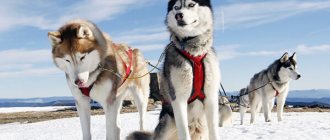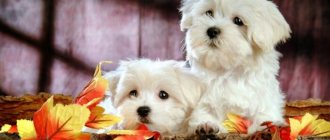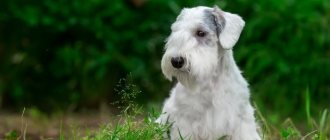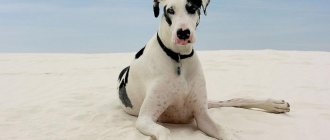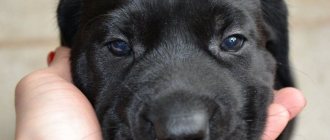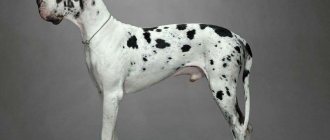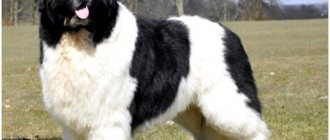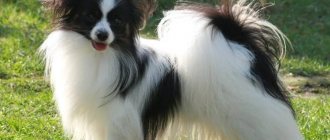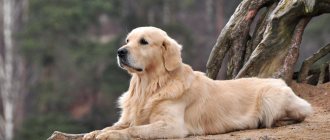If a few decades ago Bloodhound dogs were considered only as hunting assistants, now they proudly bear the title of noble and aristocratic animals. The gracefulness of these pets is given by their large size, proud appearance, docile nature and unusual appearance.
Such animals are rightfully considered man’s best friends, and we’ll tell you why below.
History of the Bloodhound breed
Belgium is considered the birthplace of the Bloodhound, but the breed became most widespread and popular in England in the 11th century. It is believed that these dogs were brought to the territory of the kingdom by William the Conqueror.
Confirmation of this can be found in works of art - in portraits of Elizabeth I and other royals, as well as in Shakespeare's great comedy A Midsummer Night's Dream.
The breed was brought to Russia by Peter I, but hounds were seriously bred only while he was alive. The breed returned to popularity in the country only in the second half of the 20th century.
The name is explained by the translation of the word “blood” (from English - blood) - the hound of this breed was excellent at searching for wounded prey by blood during the royal hunt, as well as fugitive criminals during the raid of guard services.
Nutrition
Let's start with the main thing. A sudden change in diet is detrimental to the bloodhound’s gastrointestinal tract. If you previously gave your dog food from your table, and then decided to switch him to dry food, do it gradually. For example, add the dry product to a bowl of porridge little by little, increasing the portion each time.
The stomach is a vulnerable organ of such a dog. Therefore, it is important to feed her properly. Dry food is an ideal option for an adult hound dog. It includes a complex of nutrients, vitamins, for example, A, B, C, microelements, etc. Daily absorption of these microcomponents is a necessity for a healthy dog.
a Bloodhound puppy’s diet is raw, lean meat. It contains amino acids, proteins and fats necessary for the gradual development of muscles and skeleton. In addition to meat, such a dog should be given boiled chicken eggs, soups, low-fat milk, cottage cheese, cereals and fruits with vegetables.
Foods rich in iodine are fish and seaweed. If you decide to pamper your pet with this, do not overdo it. The body of a young dog cannot absorb large amounts of iodine in one meal.
The maximum amount of fish for him is 200 grams per day. Be sure to change the water in his bowl every day, especially if the dog lives outside in an enclosure. He drinks a lot because he is constantly moving.
Characteristic behavior of the Bloodhound breed
In the photo, the Bloodhound may look hostile, but they are kind, calm dogs, one might even say phlegmatic. They are comfortable being in the company of people, they get along well with children, and do not get into conflicts with other animals.
Bloodhounds are rarely chosen as guard dogs. In case of danger, these dogs will certainly defend their family, however, the process of search and pursuit is of greater interest to this breed.
It is believed that they are able to pick up a trail that is more than 300 hours old. They are not afraid of water, bloodhounds are excellent swimmers. In the process of searching for prey, they can calmly swim the required distance and even dive.
Use of bloods: police and rescuers
Bloods are quite slow, so when hunting they are often used in tandem with faster hunting dogs - they are allowed to chase the game along the scent taken by the blood. Often used in fox hunting.
Interesting fact! The Bloodhound is the first dog breed whose sense of smell has been used as evidence in court.
In addition to working in police services, bloods are often used to find lost pets and missing people. These are excellent rescuers, they can work at disaster sites and search for people under the rubble.
Bloods are excellent rescuers
External features of the Bloodhound breed
Experts characterize the description of the Bloodhound breed and its standards with the following facts:
- The average weight of a male can reach 50 kg, and a female - 45 kg
- The height of a male individual reaches 72 cm, and that of a female individual reaches 66 cm.
- the most massive part of the bloodhound’s body is the head with characteristic folds from the eyes to the neck: large nose, voluminous ears
- muscular neck, long enough to hold the head in a comfortable position for searching for prey
- strong saber-shaped tail
Choosing a puppy
A healthy Bloodhound puppy is well-fed, curious, very active, and eats well. He should have shiny fur, a wet nose, and clear eyes. The ears are long, tangled in the paws. The baby will be happy to come running to you to meet you.
A healthy Bloodhound puppy is well-fed, curious, very active, eats well
The puppy's belly should be firm, but not bloated.
Puppies are sold no earlier than two months. By this age they have a veterinary passport, all the necessary vaccinations and an official name, which is recorded in the stud book of the breed club and kennel.
The estimated cost of a puppy is about 50-100 thousand rubles.
Bloodhound dog colors
The Bloodhound has only two types of colors: one-color and two-color. A single-color color is, as a rule, one of the variations of a brown or sand shade without bright, eye-catching details.
A two-tone color can be presented in the form of a color with the addition of black massive details - a saddle cloth (covering from the base of the neck to the middle of the back, in the form of a blanket) and a cloak (covering from head to tail).
This breed does not often appear on TV screens, but you are probably familiar with the bloodhound Caesar, who played the role of the faithful friend of the main character of the television series “Plot” performed by Sergei Bezrukov. Caesar is a prime example of a two-tone saddle coat.
Another popular children's cartoon character, Pluto, is a bloodhound of a completely atypical color. The fact that the cartoon character is a bloodhound was immediately announced by its creators. However, lovers of this breed have been vehemently arguing with such visualization for decades.
Possible diseases
One of the diseases that Bloodhounds suffer from is hip dysplasia. This disease is manifested by lameness, heaviness when standing up, and an X-shaped stance of the hind limbs.
The reason is underdevelopment of the hip socket. To prevent this disease, it is necessary to take a responsible approach to feeding and under no circumstances allow these animals to become overweight.
To prevent this problem in offspring, it is necessary to exclude patients with dysplasia from breeding, because the disease is mostly hereditary. Bloodhound puppies also get this disease , and it is at this age that the first symptoms often appear.
Volvulus is another disease common to this breed. If its symptoms (bloating of the abdomen, combined with heavy breathing, a sharp weakening of the animal and vomiting foam) appear, then you must urgently contact a veterinarian, because this disease is fatal.
Bloodhound puppies
Prevention - frequent small meals (useful for people too), deprivation of physical activity immediately after eating, as well as the use of high-quality feed. Bloodhounds also have the following diseases:
- Cherry eye.
- Skin fold dermatitis.
- Elbow dysplasia.
- Entropion or inversion of the eyelid.
Most of the diseases inherent in Bloodhounds are associated with their large size and are found in other large dogs.
Features of keeping the Bloodhound breed
Bloodhound, who is forced to live in an apartment, is trying to have fun in a small area as best she can. These dogs often explore closets and storage areas for various things. Out of curiosity, they may well open the floor covering.
Bloodhounds are also quite clumsy, often unconsciously knocking over fragile objects with their powerful saber-shaped tail and crashing into furniture while running.
In addition, the bloodhound has a rather loud voice; its bark in the open air can be heard for kilometers, and in an enclosed space it can spread to the farthest corners of the house.
Breeders recommend creating comfortable conditions for the Bloodhound in a private home with the possibility of constant walking. The ideal home for this breed would be a house in the countryside or on a farm.
Character
We said above that such a dog is not at all evil, but on the contrary. He is kind, intelligent and very sensitive. Many will say that his appearance is repulsive. It's hard to disagree with this. The dog's look is indeed too suspicious and defiant, however, this is due solely to the peculiarities of its exterior, or rather to the thick elastic skin on its head.
By itself, the Bloodhound is very good-natured. His love for his family is difficult to describe in words. Once a dog falls in love with a person, he will never leave him. A representative of this breed is characterized by monogamy. The owner is chosen 1 time. Having experienced the betrayal of a loved one, the dog becomes unhappy.
Interesting ! There are known cases of bloodhounds starving to death after being abandoned by their previous owners. An animal that has previously encountered human malice has difficulty learning to trust people again. It becomes strongly attached to them and needs to be treated with respect and care.
The dog loves to play with children. She will allow them any prank, even pulling her long ears. When the baby hurts her, she will gently stop him with her paw, but under no circumstances will she bite.
Parents of babies can leave them alone with a wrinkly dog, but they must be prepared to protect themselves. Who will have to be protected, you ask? Of course an animal! Sometimes children flirt so much with the kind big guy that they hurt him, and he humbly endures it.
Advice ! If you live with a bloodhound and a small child, then teach them to interact without harming each other. For example, if you notice that your child is hurting your dog, scold him.
Among the representatives of this breed there are sometimes shy ones. Such dogs do not approach guests, wait for an invitation, do not try to run ahead of the owner and never indulge. It would seem that what's wrong with this?
In fact, only an insecure dog that is afraid of something behaves this way. If you notice this behavior in your pet, then try to spend more time with him so that he becomes bolder. Such dogs rarely come into conflict with anyone. They prefer to avoid quarrels by moving away from the irritated object. But sometimes they still express annoyance.
As a watchdog, the Bloodhound is ineffective. He will probably avoid people who come to the house rather than attack them. This is due to the absence of natural anger and the desire to establish relationships with every living creature.
Hound dogs have a specific character trait - a boundless interest in the world. They are active and always strive to explore new places, gain unique experience, run in different areas, etc. Due to excessive curiosity, they can get lost.
Bloodhound dogs have an excellent sense of smell.
Caring for the Bloodhound breed
The Bloodhound's coat is short and elastic, it does not require special care, only when it gets dirty. It is enough to comb the wool with a rubber mitten once a week and monitor eye and ear hygiene.
Bloodhoud's eyes are prone to souring, so once a week they need to be wiped with strong tea or a special solution.
Dogs of this breed explore all objects that come their way, so after each walk it is necessary to inspect the dog’s face, ears, folds in detail and clean them of dust, soil, cobwebs and other debris.
Care is complicated by the fact that Bloodhounds are a “drooling” dog breed and owners need to closely monitor the condition of the dog’s nose and mouth.
You only need to walk a Bloodhound on a leash, because if a representative of this breed picks up a trail that is interesting to him, the owner simply will not be able to keep up with him.
General characteristics of the breed
The Bloodhound is a large hound. It belongs to the hunting breeds with an ancient history. Even the name speaks about this: bloodhound translates as blood dog or blood hound. That is, the purpose of these dogs is to hunt for a blood trail. They have such a keen sense of smell that they can track prey by small and even old scents. But there is a second interpretation of the name - this is “a hound of noble blood.”
Modern representatives of the breed are not tied to hunting. Bloodhounds can be bloodhounds, trackers, and are ready to follow a scent for hours, sniffing the territory many times. That's why they are used by the police and rescue services. They have no equal in searching for missing people, escaped criminals, and prohibited substances.
Often these dogs are taken as a companion. They are calm, obedient and friendly. They just need a lot of physical activity, so they are more suitable for an active, athletic owner.
Another feature of the breed is that you should not attract a bloodhound for protection or protection. Despite its large size and menacing appearance, it is completely devoid of aggression towards humans. This is a calm, good-natured and flexible dog. Although his appearance and sonorous bass bark can frighten a stranger.
| Options | Characteristic |
| Name | Bloodhound, Belgian hound |
| country of origin | Belgium |
| group of breeds according to the ICF classification | hounds and related breeds, large hounds section |
| application | hound, tracker, bloodhound, service dog, companion |
| character traits | good-natured, balanced, flexible, sociable, inquisitive |
| life expectancy | 8-10 years |
| height | males 64-72 cm, females 58-66 cm |
| weight | males 46-54 kg, females 40-48 kg |
| aggression | No |
| activity | high |
| intelligence | smart, but difficult to train |
| difficulty of care | easy, although it sheds heavily twice a year |
pros
The Blandhound is a calm, good-natured dog, an ideal companion and loyal friend. Suitable for families with children, active owners. Representatives of the breed have several advantages:
- acute sense of smell, they have the best scent among dogs;
- this is an excellent hunter and bloodhound;
- balanced, calm character;
- dogs are quite clean and do not require serious care;
- they are people-oriented, loyal and affectionate;
- completely devoid of aggression, will never bite or even growl;
- friendly to all people, hospitable;
- get along well with other pets and never get into conflicts;
- love children, can be a nanny, tolerate any tricks;
- hardy, hardworking, suitable for service in the police, the Ministry of Emergency Situations.
Minuses
The Bloodhound is not an easy dog. Despite the many advantages, it is not suitable for everyone. This is a hound, so it requires exercise. You will have to run and walk a lot with your pet. Homebodies or inactive people should not get this breed. And due to their impressive size, bloodhounds do not get along well in a city apartment. They have a few more disadvantages.
- These dogs are very stubborn, although they are smart and smart, they do not like to learn. Therefore, to train a bloodhound, you will have to work hard.
- Due to the presence of jowls, they are slobbery. This can be a problem for purists. You will need to wipe your pet's face several times a day.
- Bloodhounds are voracious, picking up and eating everything they can chew and swallow. You need to immediately wean yourself off this habit and constantly carefully monitor your pet and its diet.
- If a dog is attracted by an interesting smell on the street, it will follow the scent without noticing anything. It can get lost, because in this state it does not respond to the owner’s commands. Therefore, older people and disabled people should not own a bloodhound.
- Dogs of this breed mature slowly. Mental and physical development is fully completed only by 2.5-3 years. All this time you need to pay serious attention to education.
- Despite the fact that the coat is short, it sheds heavily. And when wet, it smells unpleasant.
- Bloodhounds snore and bark loudly. Although they rarely speak, it is very low and rough.
The video complements the description of the breed:
Video: Bloodhound. Pros and cons, price, how to choose, facts, care, history
Video: Bloodhound. Breed characteristics, care
Video: Bloodhound - a film about the breed
Raising and training Bloodhound dogs
As a Bloodhound grows, it is important not to overload it physically so that its body develops correctly. Up to 8 months, puppies are even often carried in their arms, not allowing them to overcome difficult climbs.
The Bloodhound is easy to train if he is involved in an interesting game with a reward.
However, we should not forget that the Bloodhound is a bloodhound, and can suddenly switch to more interesting entertainment. Therefore, training should take place in a closed area, and the dog’s attention should be completely captured by the one who is training it.
Also, we must not forget about the large dimensions of the dog and the fact that during the process of playing and training, it can easily lay its trainer on its shoulder blades. Classes should be conducted in a playful manner, but the dog must be shown that its behavior is being closely monitored.
Training
Raising a bloodhound is not easy, as restless and overly energetic dogs are difficult to train and train.
It is best to hire a special instructor for these purposes, and when choosing an independent option, take your time, do not tease, use game forms and do not use “whip” methods.
How to choose a bloodhound puppy
You can choose a Bloodhound puppy from the age of 2-3 months. If you choose a puppy under 1 year of age, pay attention to its weight.
This breed is prone to gaining excess weight, but for puppies that are a few months old this is normal, but for older ones it can mean health problems and improper care from the breeder.
In addition, it is necessary to clarify information about the puppy’s parents and show it to a veterinarian in order to eliminate health risks.
By choosing the Bloodhound breed as a pet, you are making the right choice. These are kind and loyal dogs that, with proper care and maintenance, will be faithful friends and helpers in their favorite hobby.
Nurseries
There are not many breeders in Russia who are professionally involved in breeding bloodhounds. The main part is concentrated in the capital region. You can view photos of animals and purchase purebred Saint-Hubert dog puppies in the following kennels in Moscow:
- “Ksenia’s Hope” https://www.bloodhound-nadezhda-ksenii.ru;
- “The Legend of Arden” https://bloodhound-la.narod.ru.
The Bloodhound is a breed with a keen sense of smell and a loving heart. This hound must be led by a strong but fair leader. Long walks and the opportunity to always be close to the owner are a simple recipe for happiness for Saint-Hubert dogs.
Photos of Bloodhound dogs
Reproduction and lifespan
Good nature is the main character trait of this dog. But even she can show intolerance. Usually, Bloodhounds get angry at their own kind when they behave too obsessively. Yes, a bitch can push away a male during an introduction.
Therefore, the breeder should know that dogs should be bred in the warm season, preferably in late spring, when her interest in breeding is at its highest. Purebred dogs must be selected before the breeder breeds them. Standard requirements for candidates:
- Full compliance with the standard.
- Lack of anger.
- Loud loud barking.
- Moderate activity.
- Showing sexual interest.
- Impeccable health.
- Reaching the minimum age for mating is 2 years.
If conception has occurred, then after 3 weeks you can see the rounding on the bitch’s peritoneum. She carries the offspring for 67 to 72 days. An aristocratic hunter lives from 10 to 12 years.
Appearance
At the withers, Bloodhounds are from 58 to 69 cm. They weigh from 36 to 50 kg. The dogs move quickly. They beautifully pursue ungulates while hunting at a gallop or trot. Their head is of an original shape, large, and the muzzle is elongated. The brow ridges are raised. The ears are gorgeous - large, hanging and soft to the touch. There are folds on the body that need to be taken care of to prevent diaper rash.
The coat is short. If you run your hand over it, it is smooth and thick. The breed contains the most red dogs, but there are also:
- Black with small white spots;
- Black and tan (red);
- Fawn;
- Reddish brown.
With excellent care, the Bloodhound dog breed lives up to 10-12 years and delights the whole family with its magnificent character.
Features of the sense of smell in dogs
In terms of acuteness of smell, absolutely any dog is many times superior to a representative of the human race . A dog's delicate sense of smell is capable of picking up tens of thousands of different odors, while clearly distinguishing them even at the most insignificant concentrations. The animal actively collects odor information, using the special structure of the olfactory organs. The movable dog nose has side cutouts that allow it to collect information from the air not only from the front and sides, but also from the back. The nostrils fold in a special way, and the animal does not even need to turn its head. The maximum coverage sector is about 130–150°.
On average, a dog’s brain is 10 times smaller than a human’s, but the area responsible specifically for smell is 40 times larger than the olfactory lobe of the brain in humans . The ability to identify odors is almost 10 thousand times higher. The ability to sniff, expressed in several cycles of respiratory movements of 3–7 intense inhalations of air, makes it possible to obtain more data for analysis.
A dog's nose has a unique structure
The mucus that covers the inside of the nasal cavities serves mainly to capture odorant molecules from the air and move them to the receptor cells, and not only to cool the nose.
The epithelium with special receptor cells that lines the mucous membranes of the nose is only 0.006 mm thick in humans, while in canines it reaches 0.1 mm. The total weight of the olfactory bulbs is 4 times greater than that of a person, and they themselves are much larger. The total area of smell receptors in dogs is about 390 cm2 (everything is determined by the length and size of the dog’s muzzle), while in their owners it is no more than 7 cm2. The number of olfactory cells in dogs of different breeds varies from 125 to 300 million; in homo sapiens there are no more than 5 million.
The structure of a dog's nasal cavities is very different from that of a human.
Nature has endowed canines with a very unusual vomeronasal organ located in the mouth (on the roof of the mouth). It is assumed that this small bump detects pheromones, which are practically undetectable to the human nose. Although the true purpose of the vomeronasal organ, as it is also called, is still completely unknown.
Video: How dogs see the world with their noses
What to feed a bloodhound
They are fed, like all other dogs, either dry food or natural food.
Dry food is exclusively premium, in which real meat comes first, not soy and beans. Something like Akana.
In natural food, lean meat scalded with boiling water predominates. In second place in terms of volume of porridge are rice, buckwheat, and millet. Optionally, vegetables, fish, eggs, and dairy products rich in calcium are added. Dried offal, pieces of fruit, and wheat crackers are given as treats.
Like most hounds, Bloodhounds do not know limits when it comes to food. This is useful in training - a treat is the best motivation, the pet will do anything for it. But feeding is not very good; the dog can easily become fat.
Therefore, nutrition is strictly controlled, treats are taken into account, and food is never left in the bowl after breakfast or dinner is finished. No handouts from the table. Nothing spicy, fatty, sweet.
Proper nutrition is the key to a long life for a dog.
